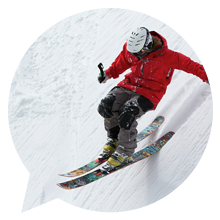Skiing and snowsports

Introduction
Alpine skiing and snowboarding are incredibly popular activities. Currently some 40 million alpine skiers venture to resorts worldwide at this time of year.
Snowsports by their nature are high speed, increasingly involving jumps and aerial tricks, undertaken often in removed wild environments. As with any activity there will always be accidents, however the right preparation, using the right gear and gaining the right skills and knowledge can massively reduce the risk of serious injury, and help you have a good time.
Before you go
Are you good to go?
Skiing and snowboarding can be physically demanding. Many people are injured because, quite simply, they are not fit enough. Common injures such as knee injuries, strains and sprains can be reduced by improving your fitness before the holiday – either in your gym or at the local ski slope. Allow a couple of months for this.
Practice, practice, practice
Getting some lessons in advance will both improve your fitness and skill levels – both of which will help to reduce your risk of injury while on holiday and (hopefully) allow you to progress and do more on your trip.
Know before you go
Check exactly what your insurance covers (especially medical repatriation), what rescue services are available on the slope, and what the weather/snow conditions will be. This is especially the case if you travel or book your holiday independently of a travel company.
All the gear
Snow sport shops offer tons of shiny kit to part you from your cash. Ask yourself the following: Will it make a difference to my safety or comfort? And importantly: Do I know how and when to use the gear? An important consideration is whether to wear a helmet. We would advise that all children and adults wear a helmet on the slope and many resorts and ski schools insist on this. It is a personal choice for an adult, but studies have shown that wearing a helmet can decrease the severity of head injuries, and they keep your ears warm!
Finally, check and maintain your kit. Make sure that the kit you have is suitable for you, using inappropriate borrowed kit can massively increase the risk of injury!
At the slope
Polish your skills
If it is your first time on the slope, lessons are essential. If you haven't been out for a while then a short refresher course would be very useful. Working up your fitness level, knowing the code of conduct and how to use the safety kit, and, importantly, understanding the risks involved will mean you become a better skier and have a more enjoyable experience.
Warm up, stretch and cool down
As with any demanding activity, a thorough stretching and warming up or cooling routine will help reduce the risk and possibly severity of injury.
Stay on track
Keeping on piste and using the local resort information will mean that if something does go wrong, help will quickly be on hand.
Keep a weather eye
A ski resort may have all the facilities you need, but it is still a mountain environment and, as such, the conditions can change very quickly.
Don't ski alone
Being part of group is much, much better for you if things go wrong.
Quit while you are ahead
It's natural to want to push yourself, especially if you are really keen to get out or just make the most of the last day. Injures are more likely to happen if you are tired. In the long run, an injury could keep you off work, and worse, stop you from getting back onto the slope for a long time.
And finally, follow the FIS rules of conduct
If you don't know what they are, then find out!
Other points
Off piste – is for the very experienced only. The best way to gain this experience is by using the skills of a professional guide. Be aware that some countries and insurers are either charging for rescue or not offering cover for this type of skiing.
Children – are more susceptible to cold weather, and will become tired more easily. Making sure they have the right clothing and kit is important. Most reputable resorts are well equipped for children. In the UK, use a ski school and instructors that are members of BASI.
References and further information